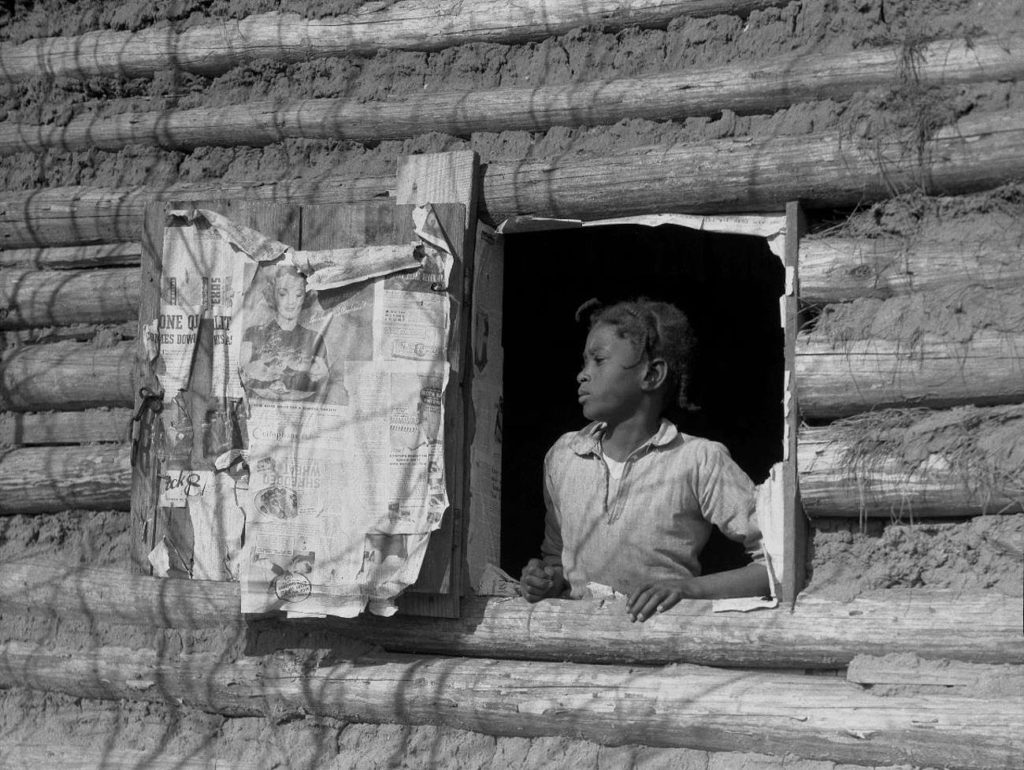Text by Bruce Berman, Site Editor
“You see the girl — that’s effect one. You see the ad [the blond woman] — that’s effect two. But the third effect is when you see both images together and recognize the irony.” — Arthur Rothstein on the photo
It’s a beautiful photograph, no doubt. Rule of thirds composition. Great light creating great texture. Juxtaposition of the printed rumpled paper against the real person, Black tones versus light tones, i.e., contrast. The slightly diagonal lines and the pattern they create. Textbook rules of composition. But, of overwhelming importance, of course, the implied comment and intention of the photograph.
Arthur Rothstein understood and believed in the power of photography to make social commentary. Working for the United States government, Rothstein photographed Artelia Bendolph in Alabama, to illustrate the effects of the Bankhead-Jones Farm Tenancy Act of 1937.
Of course -and this is NEVER supposed to be asked when discussing the iconic FSA project- should someone working for the government EVER be allowed to use their words or photographs to “make social commentary?” Isn’t that the realm of commentators in the news industry, i.e., non tax paid?
How can the government, endowed with all its resources unavailable to almost any private enterprise, be trusted to always tell the truth, as opposed to tell the viewpoint of someone or some organization to make commentary about their viewpoint of society and how society should be?
Even if there is right and wrong and the government feels they’re in the right, this is dangerous territory. If allowed, what happens when the day comes and the government is pushing a vision for society that is wrong?
The Farm Security Administration (FSA) was created to show the works of the Agriculture Department in their effort to fight the depravations of The Depression. Does Rothstein’s “social commentary,” have some magic power to make the plowed-out and overworked land healthy again and right the wrongs of society? Does the government develop a tree line (one of the main land reclamation projects)to stop the winds of dust, fifteen years after it should have been done, by showing the contrast of an impoverished woman in her rough hewn home in contrast with a glamorous advertisement plastered to her shutter?
What’s my point?
More like a reminder.
Our view of the 1930’s and, really, ever since, was shaped by a young, dedicated, Left-leaning group of activists with cameras, directed by a Colombia University Economist, who was closely allied to FDR’s new deal (he was there because his mentor, Rex Tugwell, Rooseveldt’s advisor). It isn’t a bad view. It is a view that I, personally agree with much of.
But that’s not the point. The point is that we need to question the view because it was paid for by taxpayer’s money, all of the taxpayers and that wherever there is a viewpoint there is a counter viewpoint and that the truth can only be known by examining all viewpoints, not just one side’s. That is the root idea of a free press. It is supposed to find sources, opposing sources if possible, and sort through WHAT it is, WHO it is, WHERE it happened, WHY it happened and WHEN (in this case historically).
Those are the sacred and eternal 5Ws of journalism and it’s not clear in the work of the FSA that they asked without prejudice, that if asked they weren’t asked from opposing viewpoints.
The definition of the word propaganda is, “… information, especially of a biased or misleading nature, used to promote or publicize a particular political cause or point of view.”
OK.
But since the FSA was funded by all taxpayers and not just those from one viewpoint, wouldn’t the work of the FSA have more long-lasting validity if they had adhered to the rules of information-gathering followed by good journalists?
That would be a historic document that would reveal information useful to us for all future times.

